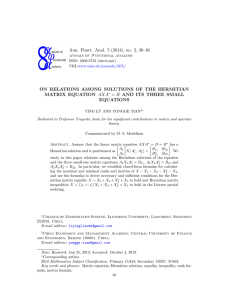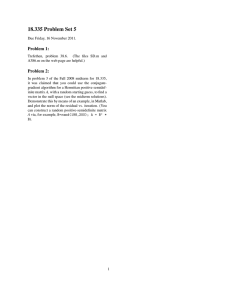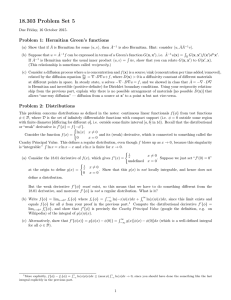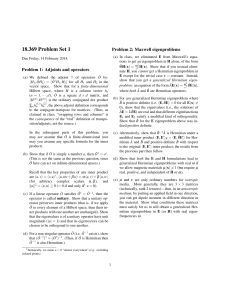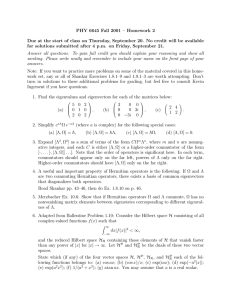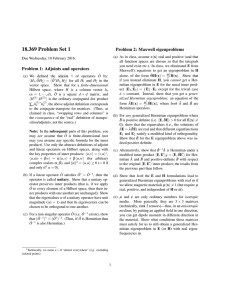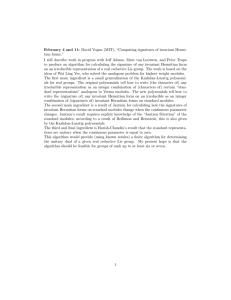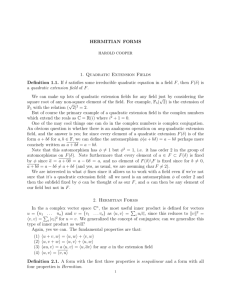Acta Mathematica Academiae Paedagogicae Ny´ıregyh´aziensis 21 (2005), 33–42 www.emis.de/journals ISSN 1786-0091
advertisement
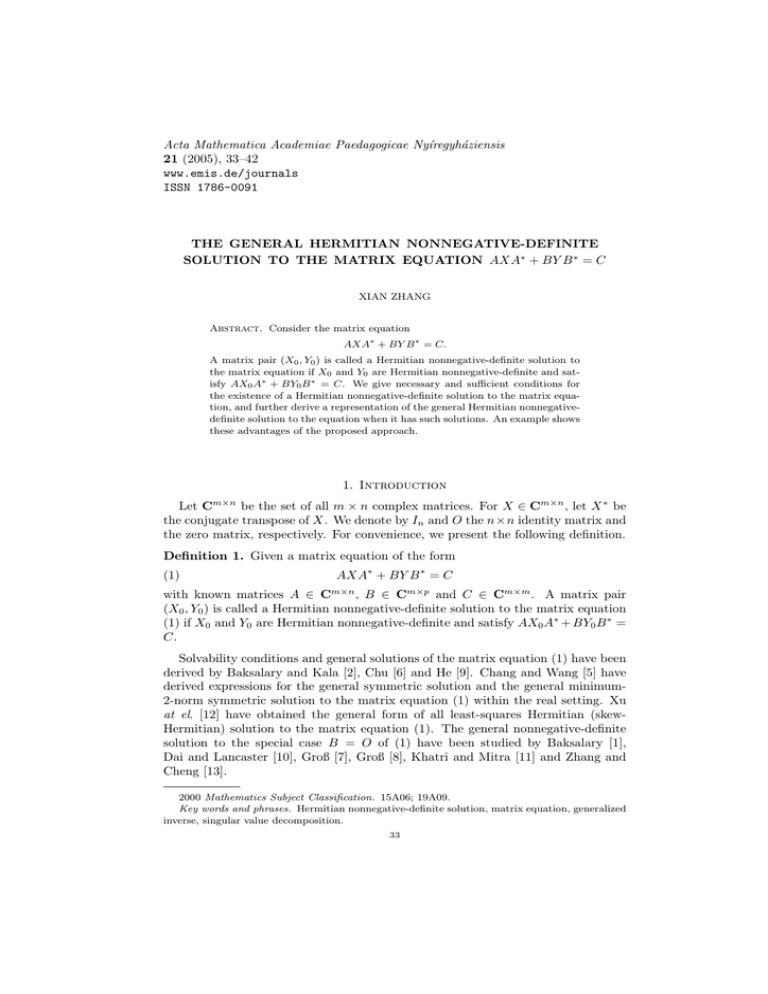
Acta Mathematica Academiae Paedagogicae Nyı́regyháziensis 21 (2005), 33–42 www.emis.de/journals ISSN 1786-0091 THE GENERAL HERMITIAN NONNEGATIVE-DEFINITE SOLUTION TO THE MATRIX EQUATION AXA∗ + BY B ∗ = C XIAN ZHANG Abstract. Consider the matrix equation AXA∗ + BY B ∗ = C. A matrix pair (X0 , Y0 ) is called a Hermitian nonnegative-definite solution to the matrix equation if X0 and Y0 are Hermitian nonnegative-definite and satisfy AX0 A∗ + BY0 B ∗ = C. We give necessary and sufficient conditions for the existence of a Hermitian nonnegative-definite solution to the matrix equation, and further derive a representation of the general Hermitian nonnegativedefinite solution to the equation when it has such solutions. An example shows these advantages of the proposed approach. 1. Introduction Let Cm×n be the set of all m × n complex matrices. For X ∈ Cm×n , let X ∗ be the conjugate transpose of X. We denote by In and O the n×n identity matrix and the zero matrix, respectively. For convenience, we present the following definition. Definition 1. Given a matrix equation of the form (1) AXA∗ + BY B ∗ = C with known matrices A ∈ Cm×n , B ∈ Cm×p and C ∈ Cm×m . A matrix pair (X0 , Y0 ) is called a Hermitian nonnegative-definite solution to the matrix equation (1) if X0 and Y0 are Hermitian nonnegative-definite and satisfy AX0 A∗ + BY0 B ∗ = C. Solvability conditions and general solutions of the matrix equation (1) have been derived by Baksalary and Kala [2], Chu [6] and He [9]. Chang and Wang [5] have derived expressions for the general symmetric solution and the general minimum2-norm symmetric solution to the matrix equation (1) within the real setting. Xu at el. [12] have obtained the general form of all least-squares Hermitian (skewHermitian) solution to the matrix equation (1). The general nonnegative-definite solution to the special case B = O of (1) have been studied by Baksalary [1], Dai and Lancaster [10], Groß [7], Groß [8], Khatri and Mitra [11] and Zhang and Cheng [13]. 2000 Mathematics Subject Classification. 15A06; 19A09. Key words and phrases. Hermitian nonnegative-definite solution, matrix equation, generalized inverse, singular value decomposition. 33 34 XIAN ZHANG As the supplements of [5] and [12] and the extensions of [1], [10], [7], [8], [11] and [13], this paper establishes the following problem: Problem 1. Given matrices A ∈ Cm×n , B ∈ Cm×p and C ∈ Cm×m . Determine necessary and sufficient conditions for the existence of a Hermitian nonnegativedefinite solution to the matrix equation (1). Furthermore, give a representation of the general Hermitian nonnegative-definite solution to the equation (1) when it has such solutions. Now we make the following several notes about Problem 1. • Since (1) can be write as ¸ · £ ¤ XA∗ £ A B = AX Y B∗ (2) (3) (4) which implies £ rank A B C ¤ = rank £ A B BY ¤ ¤ · = rank A∗ B∗ £ ¸ A = C, B C∗ ¤ is a necessary condition for the matrix equation (1) to have a solution. • If n + p < m, then there exists a unitary matrix P such that · ¸ · ¸ A1 B1 PA = , PB = , O O where A1 ∈ C(n+p)×n and B1 ∈ C(n+p)×p . This, together with (2), implies ¸ · C1 O ∗ , C1 ∈ C(n+p)×(n+p) . P CP = O O Substituting (3) and (4) into (1) gives (5) A1 XA∗1 + B1 Y B1∗ = C1 . Obviously, the matrix equations (1) and (5) have the same solutions. • It is clear that C is Hermitian nonnegative-definite if the matrix equation (1) has a Hermitian nonnegative-definite solution. Thus, to ensure its solvability, we can write C = DD∗ for some D ∈ Cm×m . • If A = O or B = O, then (1) turns into BY B ∗ = C or AXA∗ = C. In this case Problem 1 has been solved by several authors. (see [1], [10], [7], [8], [11] and [13]). Based on the above four notes, in order to solve Problem 1, it suffices to solve the following Problem 10 . Problem 10 : Given matrices A ∈ Cm×n , B ∈ Cm×p and D ∈ Cm×m satisfying (6) m ≤ p + n, A 6= O, B 6= O. Determine necessary and sufficient conditions for the existence of a Hermitian nonnegative-definite solution to the matrix equation (7) AXA∗ + BY B ∗ = DD∗ . Furthermore, give a representation of the general Hermitian nonnegativedefinite solution to the equation (7) when it has such solutions. THE GENERAL SOLUTION TO THE MATRIX EQUATION. . . 35 2. Solution to Problem 10 This section solves Problem 10 proposed in Section 1. We first introduce the following two lemmas. The first one can be easily derived from [3, Lemma 2.1] and the second is taken from [4, p. 270]. Lemma 1. Given two positive integers n1 and n2 satisfying n1 ≤ n2 , and two matrices F ∈ Cn1 ×n1 and G ∈ Cn1 ×n2 . Then F F ∗ = GG∗ if and only if G = F T for some T ∈ Cn1 ×n2 satisfying T T ∗ = In1 . Lemma 2. Given matrices M ∈ Cm×p and N ∈ Cm×n . Let M − be an arbitrary but fixed generalized inverse of M . Then the matrix equation M X = N has at least a solution if and only if M M − N = N . When this condition is met, the general solution to the equation is given by X = M − N + (Ip − M − M )Y, where Y is free to vary over Cp×n . Combining Lemmas 1-2, the solution to Problem 10 can be stated as follows. Theorem 1. Given matrices A ∈ Cm×n , B ∈ Cm×p and D ∈ Cm×m satisfying (6). Let A− and B − be arbitrary but fixed generalized inverses of A and B, respectively. Then (i) the matrix equation (7) has at least a Hermitian nonnegative-definite solution if and only if there exist T1 ∈ Cm×n and T2 ∈ Cm×p satisfying T1 T1∗ + T2 T2∗ = Im (8) and AA− DT1 = DT1 , BB − DT2 = DT2 . (9) (ii) when (8) and (9) are met, a representation of the general Hermitian nonnegative-definite solution to the matrix equation (7) is given by (X, Y ) = (V V ∗ , W W ∗ ) (10) with V = A− DT1 + (In − A− A)Z1 (11) and W = B − DT2 + (Ip − B − B)Z2 , (12) where Z1 ∈ Cn×n and Z2 ∈ Cp×p are a pair of arbitrary parameter matrices, and T1 and T2 are a pair of parameter matrices satisfying (8) and (9). Proof. (i) The “if ” part. Suppose there exist T1 ∈ Cm×n and T2 ∈ Cm×p satisfying (8) and (9). It follows from (9) and Lemma 2 that (13) for some V ∈ C AV = DT1 , BW = DT2 n×n and W ∈ Cp×p . Thus, A (V V ∗ ) A∗ + B (W W ∗ ) B ∗ = DT1 T1∗ D∗ + DT2 T2∗ D∗ = D (T1 T1∗ + T2 T2∗ ) D∗ . This, together with (8), implies that (V V ∗ , W W ∗ ) is a Hermitian nonnegativedefinite solution to the matrix equation (7). 36 XIAN ZHANG The “only if ” part. Suppose (V V ∗ , W W ∗ ) is a Hermitian nonnegative-definite solution to the matrix equation (7), where V ∈ Cn×n and W ∈ Cp×p . Then AV V ∗ A∗ + BW W ∗ B ∗ = DD∗ , i.e., £ ¤£ ¤∗ = DD∗ . £ ¤ Noting (6) and applying Lemma 1 to F = D and G = AV BW yields £ ¤ AV BW = DT (14) AV BW AV BW for some T ∈ Cm×(n+p) satisfying (15) £ T T ∗ = Im . ¤ Let T = T1 T2 with T1 ∈ Cm×n and T2 ∈ Cm×p . Then (15) turns into (8), and further (13) follows from (14). Combining (13) and Lemma 2 gives (9). (ii) Firstly, if the matrix pair (X, Y ) possesses the form (10) with (11) and (12), then AV = AA− DT1 , BW = BB − DT2 , and hence AXA∗ + BY B ∗ = = ∗ ∗ AV (AV ) + BW (BW ) ¡ − ¢¡ ¢∗ ¡ ¢¡ ¢∗ AA DT1 AA− DT1 + BB − DT2 BB − DT2 . This, together with (8) and (9), implies AXA∗ + BY B ∗ ∗ ∗ = (DT1 ) (DT1 ) + (DT2 ) (DT2 ) = D (T1 T1∗ + T2 T2∗ ) D∗ = DD∗ , i.e., (X, Y ) is a Hermitian nonnegative-definite solution to the matrix (7). ³ equation ´ Secondly, for any fixed Hermitian nonnegative-definite solution X̃, Ỹ to the matrix equation (7), we can write X̃ = Ṽ Ṽ ∗ , Ỹ = W̃ W̃ ∗ for some Ṽ ∈ Cn×n and W̃ ∈ Cp×p . By a similar argument to the proof of the “only if” part of (i), we can obtain AṼ = DT̃1 , B W̃ = DT̃2 m×n for some T̃1 ∈ C and T̃2 ∈ Cm×p satisfying T̃1 T̃1∗ + T̃2 T̃2∗ = Im and AA− DT̃1 = DT̃1 , BB − DT̃2 = DT̃2 . ³ ´ This, together with Lemma 2, derives that X̃, Ỹ possesses the form (10) with (11) and (12). The proof is done. ¤ Using Theorem 1, we have the following corollary which gives a representation of the general Hermitian nonnegative-definite solution to the matrix equation (16) AXA∗ + BY B ∗ = O with known matrices A ∈ Cm×n and B ∈ Cm×p . THE GENERAL SOLUTION TO THE MATRIX EQUATION. . . 37 Corollary 1. Given matrices A ∈ Cm×n and B ∈ Cm×p satisfying (6). Let A− and B − be arbitrary but fixed generalized inverses of A and B, respectively. Then the general Hermitian nonnegative-definite solution to the matrix equation (16) is given by (X, Y ) = (V V ∗ , W W ∗ ) with V = (In − A− A)Z1 , W = (Ip − B − B)Z2 , where Z1 and Z2 are a pair of arbitrary parameter matrices. Theorem 1 shows that if the matrix equation (7) has a Hermitian nonnegativedefinite solution, then its general Hermitian nonnegative-definite solution can be obtained once the general solution (T1 , T2 ) to the pair of matrix equations (8) and (9) is derived. Note that the general solution (T1 , T2 ) to the matrix equation (9) is given by (17) (T1 , T2 ) = (E1 U1 , E2 U2 ) , with E 1 = Im − and E2 = Im − £¡ ¢ ¤− £¡ ¢ ¤ Im − AA− D Im − AA− D £¡ ¢ ¤− £¡ ¢ ¤ Im − BB − D Im − BB − D , − where [(Im − AA− ) D] is an arbitrary but fixed generalized inverse of (Im − − AA− )D, [(Im − BB − ) D] is an arbitrary but fixed generalized inverse of (Im − − m×n BB )D, and U1 ∈ C and U2 ∈ Cm×p are a pair of arbitrary parameter matrices. Substituting (17) into (8) yields E1 U1 U1∗ E1∗ + E2 U2 U2∗ E2∗ = Im . (18) Therefore, to determine the general solution (T1 , T2 ) to the pair of matrix equations (8) and (9), it suffices to give a representation of the general solution to the matrix equation (18). While this can be easily obtained by using singular value decompositions (for detail see the Appendix). 3. An Example Consider the matrix equation (1) with the parameter matrices: 0 −1 1 1 2 1 0 0 2 1 , B = 1 −1 , C = 0 1 0 . A= 2 4 4 2 2 4 0 0 0 Obviously, m = n = 3 and p = 2. By form (7) satisfying (6). Choosing 1.1765e − 001 A− = −4.1176e − 001 5.8824e − 001 and · B − = 6.6667e − 002 6.6667e − 002 choosing D = C, it is clear that (1) is of the 4.7059e − 002 9.4118e − 002 3.5294e − 002 7.0588e − 002 3.5294e − 002 7.0588e − 002 6.6667e − 001 1.3333e − 001 −3.3333e − 001 1.3333e − 001 ¸ , 38 XIAN ZHANG we derive 2.2204e − 016 ¡ ¢ Im − AA− D = −1.1102e − 016 −2.2204e − 016 and ¢ ¡ Im − BB − D = 8.0000e − 001 8.3267e − 017 −4.0000e − 001 −9.7145e − 017 8.0000e − 001 −4.0000e − 001 0 0 0 −2.2204e − 016 0 −2.2204e − 016 0 . −4.4409e − 016 0 Again choosing 2.2707e − 047 −9.4371e − 032 4.7185e − 032 1.0000e + 000 −5.0000e − 001 = −2.4061e − 016 0 0 0 £¡ ¢ − Im − AA D ¤− and £¡ Im − BB ¢ − D we have ¤− 1.0000e + 000 1.0408e − 016 −5.0000e − 001 = 2.4805e − 031 2.5818e − 047 −1.2403e − 031 , 0 0 0 1.0000e + 000 9.4371e − 032 E1 = 8.6282e − 032 1.1102e − 016 0 0 and 1.1102e − 016 E2 = −2.4805e − 031 0 0 0 1.0000e + 000 0 0 . 1.0000e + 000 −1.9722e − 031 1.0000e + 000 0 Following the lines in Appendix, it is easy to see that a representation of the general solution to the matrix equation (18) is given by (19) −b1 U1 = b7 b4 −b2 b8 b5 −b3 a3 b9 , U2 = a1 b6 a5 a4 a2 , a6 where ai , i = 1, . . . , 6, and bi , i = 1, . . . , 9, are complex parameters satisfying (20) |a1 |2 + |a2 |2 = 1 a3 a1 +a4 a2 −30 9007199254740992 = 0.1109 × 10 a5 a1 + a6 a2 = 0 2 2 |a3 | +|a4 | =1 |b1 |2 + |b2 |2 + |b3 |2 + 81129638414606681695789005144064 a3 a5 +a4 a6 b1 b4 + b2 b5 + b3 b6 − 9007199254740992 = 0 |b4 |2 + |b5 |2 + |b6 |2 + |a5 |2 + |a6 |2 = 1 . THE GENERAL SOLUTION TO THE MATRIX EQUATION. . . 39 Substituting (19) into (17) yields 245b7 −b1 + 2596148429267413814265248164610048 7b1 b7 T1 = − 81129638414606681695789005144064 + 9007199254740992 b4 245b8 2596148429267413814265248164610048 7b2 b8 − 81129638414606681695789005144064 + 9007199254740992 −b2 + (21) b5 245b9 2596148429267413814265248164610048 7b3 b7 − 81129638414606681695789005144064 + 9007199254740992 −b3 + b6 and T2 = a1 a3 9007199254740992 − 5070602400912917605986812821504 1416143659252943a3 + a1 − 5708990770823839524233143877797980545530986496 a5 a4 a2 9007199254740992 − 5070602400912917605986812821504 1416143659252943a4 − 5708990770823839524233143877797980545530986496 + a2 (22) . a6 Using Theorem 1, we derive that the general Hermitian nonnegative-definite solution to the matrix equation (1) is given by (10) with 1.1765e − 001 4.7059e − 002 0 V = −4.1176e − 001 3.5294e − 002 0 T1 5.8824e − 001 3.5294e − 002 0 5.2941e − 001 −3.5294e − 001 −3.5294e − 001 2.3529e − 001 2.3529e − 001 Z1 + −3.5294e − 001 −3.5294e − 001 2.3529e − 001 2.3529e − 001 and · W = + 6.6667e − 002 6.6667e − 002 · 6.6667e − 001 −3.3333e − 001 0 −2.2204e − 016 0 0 ¸ T2 ¸ 3.3307e − 016 Z2 , −4.4409e − 016 where Z1 ∈ C3×3 and Z2 ∈ C2×2 are a pair of arbitrary parameter matrices, and T1 and T2 are, respectively, given by (21) and (22) with complex parameters ai , i = 1, . . . , 6, and bi , i = 1, . . . , 9, satisfying (20). Remark 1. The equations (20)-(22) seem at the surface to be complicated because they are computed using the symbolic operation of Maple — a tool software. In fact, they are very simple if they are computed by numerical method. 4. Acknowledgements This work was supported in part by the Chinese Natural Science Foundation under Grant No. 10271021, the Natural Science Foundation of Heilongjiang Province 40 XIAN ZHANG under Grant No. A01-07 and the Fund of Heilongjiang Education Committee for Overseas Scholars under Grant No. 1054HQ004. The author thanks the referee for his helpful comments and suggestions. References [1] J. K. Baksalary. Nonnegative definite and positive definite solutions to the matrix equation AXA∗ = B. Linear and Multilinear Algebra, 16(1-4):133–139, 1984. [2] J. K. Baksalary and R. Kala. The matrix equation AXB + CY D = E. Linear Algebra Appl., 30:141–147, 1980. [3] P. Bhimasankaram and D. Majumdar. Hermitian and nonnegative definite solutions of some matrix equations connected with distribution of quadratic forms. Sankhyā Ser. A, 42(34):272–282, 1980. [4] J. N. Buxton, R. F. Churchouse, and A. B. Tayler. Matrices Methods and Applications. Clarendon Press, Oxford, 1990. [5] X. W. Chang and J. S. Wang. The symmetric solution of the matrix equations AX +Y A = C, AXAT + BY B T = C, and (AT XA, B T XB) = (C, D). Linear Algebra Appl., 179:171–189, 1993. [6] K.-w. E. Chu. Singular value and generalized singular value decompositions and the solution of linear matrix equations. Linear Algebra Appl., 88/89:83–98, 1987. [7] J. Groß. A note on the general Hermitian solution to AXA∗ = B. Bull. Malaysian Math. Soc. (2), 21(2):57–62, 1998. [8] J. Groß. Nonnegative-definite and positive-definite solutions to the matrix equation AXA∗ = B—revisited. Linear Algebra Appl., 321(1-3):123–129, 2000. Linear algebra and statistics (Fort Lauderdale, FL, 1998). [9] C. N. He. The general solution of the matrix equation AXB + CY D = F . Acta Sci. Natur. Univ. Norm. Hunan., 19(1):17–20, 1996. [10] D. Hua and P. Lancaster. Linear matrix equations from an inverse problem of vibration theory. Linear Algebra Appl., 246:31–47, 1996. [11] C. G. Khatri and S. K. Mitra. Hermitian and nonnegative definite solutions of linear matrix equations. SIAM J. Appl. Math., 31(4):579–585, 1976. [12] G. Xu, M. Wei, and D. Zheng. On solutions of matrix equation AXB + CY D = F . Linear Algebra Appl., 279(1-3):93–109, 1998. [13] X. Zhang and M.-y. Cheng. The rank-constrained Hermitian nonnegative-definite and positive-definite solutions to the matrix equation AXA∗ = B. Linear Algebra Appl., 370:163– 174, 2003. 5. Appendix: Solution to the matrix equation (18) Since (23) rank £ E1 E2 ¤ =m is a necessary condition for (18) to have at least a solution, in this section we always assume that (23) is satisfied. Let r = rankE1 and · ¸ Σ1 O (24) E 1 = P1 Q∗1 O O be a singular value decomposition of E1 , where P1 , Q1 ∈ Cm×m are unitary and Σ1 ∈ Cr×r is positive-definite and diagonal. Case 1. Suppose r = m. Then (24) turns into (25) E1 = P1 Σ1 Q∗1 . Let (26) U1 = Q1 U11 , U11 ∈ Cm×n . THE GENERAL SOLUTION TO THE MATRIX EQUATION. . . 41 Substituting (25) and (26) into (18) derives ∗ ∗ Σ1 U11 U11 Σ1 + (P1∗ E2 ) U2 U2∗ (P1∗ E2 ) = Im . Thus, (27) £ ∗¤ ∗ U11 U11 = Σ−1 Im − (P1∗ E2 ) U2 U2∗ (P1∗ E2 ) Σ−1 1 1 . Let s = rankE2 and (28) · P1∗ E2 = P2 Σ2 O O O ¸ Q∗2 be a singular value decomposition of P1∗ E2 , where P2 , Q2 ∈ Cm×m are unitary and Σ2 ∈ Cs×s is positive-definite and diagonal. Further, assume · ¸ U21 (29) U2 = Q2 , U21 ∈ Cs×p . U22 Substituting (28) and (29) into (27) yields · ∗ Is − Σ2 U21 U21 Σ2 −1 ∗ (30) U11 U11 = Σ1 P2 O O Im−s ¸ P2∗ Σ−1 1 . ∗ Σ2 is nonnegative definite, i.e., all singular values This implies that Is −Σ2 U21 U21 of Σ2 U21 are less than or equals to 1. Therefore, by s similar argument to [13, (23)], we can determine the general expression of U21 . In summary, in this case a representation of the general solution to the matrix equation (18) is given by (26) and (29), where U22 ∈ C(m−s)×p is an arbitrary parameter matrix, U21 ∈ Cs×p is a parameter matrix such that all singular values of Σ2 U21 are less than or equals to 1, and U11 ∈ Cm×n is a parameter matrix satisfying (30). In particular, µ · −1 ¸ ¶ Σ1 O (U1 , U2 ) = Q1 ,O O O is a solution to the matrix equation (18). Case 2. Suppose r < m. Let · ¸ U11 (31) U1 = Q1 , U11 ∈ Cr×n U12 and (32) · P1∗ E2 = E21 E22 ¸ , E21 ∈ Cr×m . Substituting (24), (31) and (32) into (18) derives · ¸ ∗ ∗ ∗ Σ1 U11 U11 Σ1 + E21 U2 U2∗ E21 E21 U2 U2∗ E22 (33) = Im . ∗ ∗ E22 U2 U2∗ E21 E22 U2 U2∗ E22 It is easy to see from (23), (24) and (32) that E22 is of full-row rank. Thus, we can write £ ¤ (34) E22 = P3 Σ3 O Q∗3 , where P3 ∈ C(m−r)×(m−r) and Q3 ∈ Cm×m are unitary and Σ3 ∈ C(m−r)×(m−r) is positive-definite and diagonal. Further, assume · ¸ U31 (35) U2 = Q3 , U31 ∈ C(m−r)×p U32 42 XIAN ZHANG and (36) E21 Q3 = £ E31 E32 ¤ , E31 ∈ Cr×(m−r) . Substituting (34), (35) and (36) into (33) gives ∗ = Σ−2 U31 U31 3 ∗ (37) , E32 U32 U31 = −E31 Σ−2 3 ∗ ∗ ∗ ∗ Σ1 U11 U11 Σ1 + E32 U32 U32 E32 = Im + E31 Σ−2 E 31 3 ¡ −1 ¢2 £ −1 ¤ −2 where Σ3 = Σ3 . When U31 = Σ3 O , the relation (37) turns into ½ £ ¤ E32 U32 = −E31 Σ−1 Z 3 (38) , ∗ Σ1 U11 U11 Σ1 = Im − ZZ ∗ where Z ∈ Cr×(p−m+r) is an arbitrary parameter matrix whose all singular value is less than or equal to 1. Obviously, £ ¤ (39) rank E31 E32 = rankE32 is a necessary and sufficient condition for (38) to hold for some Z, U11 and U32 . Thus, (39) is sufficient for (37) to hold for some U11 , U31 and U32 . Furthermore, it is easy to see that (39) is also necessary for (37) to hold for some U11 , U31 and U32 . Therefore, in this case a representation of the general solution (18) is given by (31) and (35) with (37) if (39) is met. In particular, µ · −1 ¸ · £ −1 ¤ ¸¶ £ ¤ Σ1 O Σ3 O (U1 , U2 ) = Q1 , Q3 , E32 H = −E31 Σ−1 O 3 O O H is a solution to the matrix equation (18) if (39) is met. Received January 10, 2003; revised August 26, 2004. School of Mathematical Science, Heilongjiang University, Harbin, 150080, P R China E-mail address: zhangx663@sohu.com
